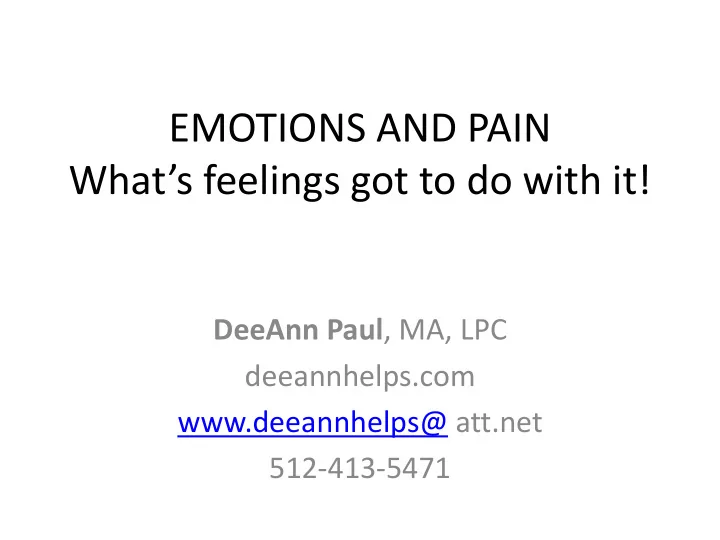

EMOTIONS AND PAIN What’s feelings got to do with it! DeeAnn Paul , MA, LPC deeannhelps.com www.deeannhelps@ att.net 512-413-5471
Brain Chemistry • What is pain – “an unpleasant sensory and emotional experience associated with actual or potential tissue damage or described in terms of such damage” (IASP, 1994) – Long Term pain can lead to changes in the nervous systems (Mart Grant) – Chronic pain functions in the nucleus accumbers and frontal cortex • Sharing the same nerve ends with emotions • These nerves ends are related to motivation and emotional behavior
Phases of Emotional Breakdown Pain Stage 1 Stage 2 Stage 3 Hurt Initial Distress Development of Acceptance of Problems illness Fear Depression Behavior response Worry Anxiety Learn new ways of living Anger New normal Substance abuse Distrust Learned helplessness Sadness
Caregivers Emotional breakdown Initial Reaction Development of emotions Acceptance Fear Anger Adjust Panic Hyper diligent Forgiveness Nervousness Depression Learn to work together Helplessness Anxiety
Belief System • Many of our beliefs about pain come from our childhood when we were influenced by family, friends, and culture. • What we learned tells us now how to react to pain. • Many of us still carry cognitive distortion about pain.
Possible Solutions • Understand and accept your pain • Use breathing techniques • Make sure you feel safe • Two evidence based treatments for pain – CBT – EMDR
CBT Theory 8 Types of Distorted Thinking • Blaming • Negative statements • Polarized thinking • Catastrophizing • Control fallacies • Emotional reasoning • Filtering • Entitlement fallacies
Blaming • Is when one holds themselves or others personally responsible for their pain problems • Self defeating attitude • If only he would have listened to me when I told him not to eat sweets. • I told him to lose weight. • Her nagging is causing me more pain.
Negative statements • Using should, must, never, always, ought • Comes across as a putdown to self • I shouldn’t feel sad. • I shouldn’t be angry because she is sick.
Polarized Thinking • View the world in black and white, no gray area • If I have a relapse my regimen is no good. • I tried this technique once and got no relief so it’s not working
Catastrophizing • Expect tragedy will happen • I’ll never get better. • What if my spouse leaves me.
Control Fallacies • Thinking one has complete control or has no control I will have to do everything now that she is in so much pain. I’m not as smart as the doctor so I can’t make the decision.
Emotional Reasoning • Believing what you feel, therefore, it must be true • I feel guilty about taking time off work, therefore, taking time off is wrong. • It’s my fault and needing time off to heal is unproductive.
Filtering • Seeing a situation as hopeless and not seeing any thing positive. • I am in so much pain I am not going to waste my time joining in. • Why should I go to that seminar. I’ll know everything there is to know about my disease.
Entitlement Fallacy • Thinking one is entitled to have a pain-free life • Having the luxury of ignoring your pain. • I have been a good person all my life, therefore, I shouldn’t get sick. • We are always on the winning side of life. Who says I can’t improve.
ABCD MODEL • A is for activating event • B is for belief systems • C is for consequences • D is disrupt or dispute the thoughts Adapted from Albert Ellis, Emotive Therapy
ABCD MODEL CONT. How does that relate to me A = Activating event: feeling pain so I must give up my commitment B = Belief system/attitudes kicks in: They will think I am weak because I didn’t do what I said I would C = Consequences: Feelings of guilt, sadness depression, anxiety, etc D = Disrupt/dispute: stop the thinking in B so you do not get to C
EMDR • Is a bilateral stimulation process that has been shown some success and being studied more extensively for chronic pain. • This bilateral or eye movement therapy works in conjunction with our medical care. • This approach for many has reduced or eliminated physical symptoms.
EMDR • Is based on the Adaptive Information Processing (AIP) Theory – Our body has an innate desire to want to be in good health – Our body has the ability to achieve good health – AIP process works with our memory network
Memory Network • Explicit: facts, general knowledge, autobiographical • Implicit: emotional response, body sensations, reflective actions response and classical condition • The information follows different neurological pathways to link with other stored memories
Memory Network • When someone experiences an event (discovered they have a disease) or trauma (surgery) this information can alter or not join with the proper links in our memory network. • Thereby storing maladaptive information that can remain frozen in a disturbed state which affects our body sensation, pain and reflexes
EMDR • The eye movements/bilateral stimulation activates the information processing system to begin the reprocessing of the disturbed aspect of the memory. • The stimulation moves the unprocessed information along the appropriate neurological pathways at an accelerated rate • Example
Emotions and Pain What’s feelings got to do with it! • Long term pain can lead to changes in the nervous system, which can maintain the pain. In a way, the pain becomes “locked” in the nervous system. • EMDR is a means of stimulating the nervous system to help it change the pain responses. • CBT helps to change those negative cognitions so one can think more clearly and positively to move forward.
Emotions and Pain What’s feelings got to do with it. • Life Event Survey – Adapted from Edmund J. Bourne • Safe/Peaceful/Comfort Place • Containment Exercise
Recommend
More recommend